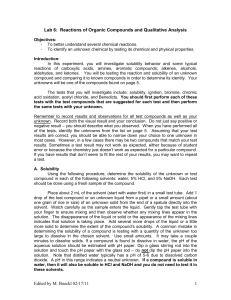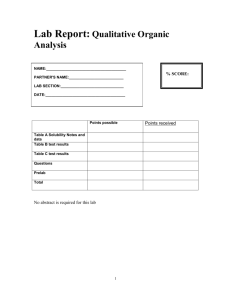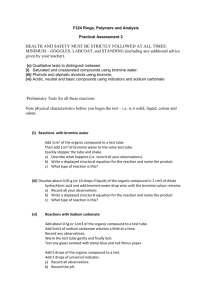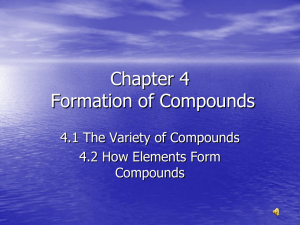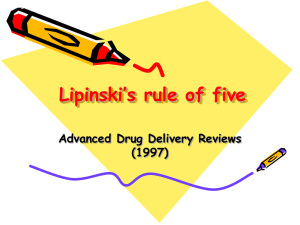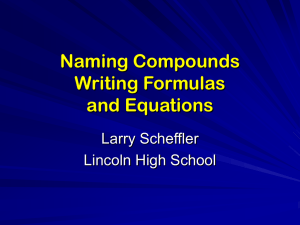Qualitative Analysis
advertisement
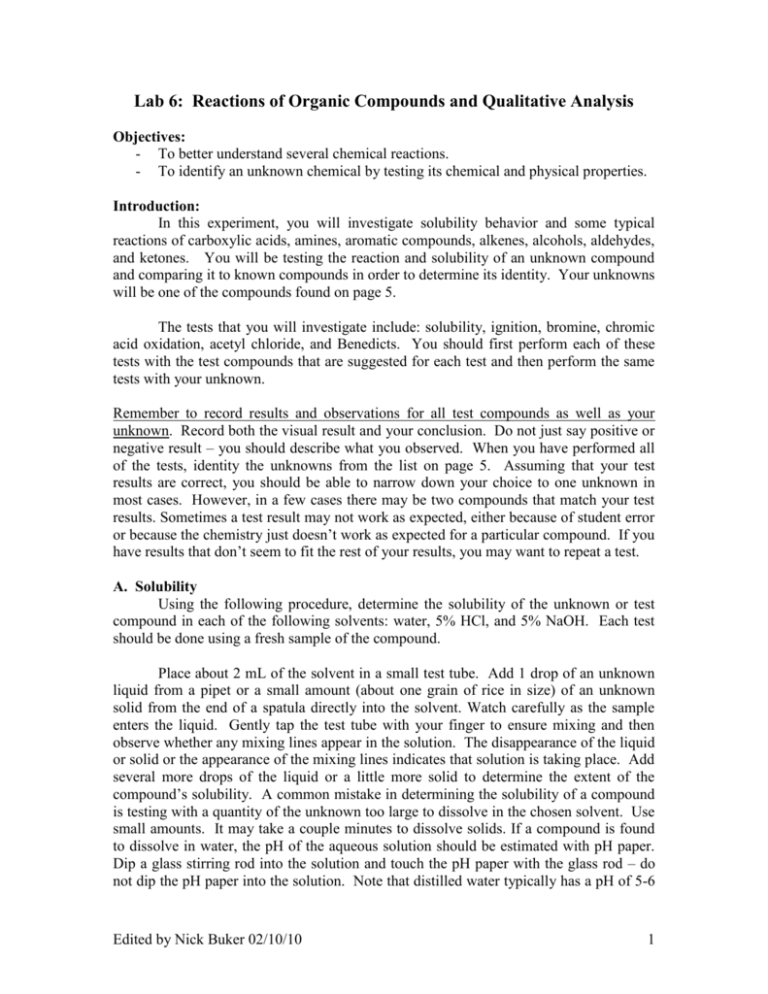
Lab 6: Reactions of Organic Compounds and Qualitative Analysis Objectives: - To better understand several chemical reactions. - To identify an unknown chemical by testing its chemical and physical properties. Introduction: In this experiment, you will investigate solubility behavior and some typical reactions of carboxylic acids, amines, aromatic compounds, alkenes, alcohols, aldehydes, and ketones. You will be testing the reaction and solubility of an unknown compound and comparing it to known compounds in order to determine its identity. Your unknowns will be one of the compounds found on page 5. The tests that you will investigate include: solubility, ignition, bromine, chromic acid oxidation, acetyl chloride, and Benedicts. You should first perform each of these tests with the test compounds that are suggested for each test and then perform the same tests with your unknown. Remember to record results and observations for all test compounds as well as your unknown. Record both the visual result and your conclusion. Do not just say positive or negative result – you should describe what you observed. When you have performed all of the tests, identity the unknowns from the list on page 5. Assuming that your test results are correct, you should be able to narrow down your choice to one unknown in most cases. However, in a few cases there may be two compounds that match your test results. Sometimes a test result may not work as expected, either because of student error or because the chemistry just doesn’t work as expected for a particular compound. If you have results that don’t seem to fit the rest of your results, you may want to repeat a test. A. Solubility Using the following procedure, determine the solubility of the unknown or test compound in each of the following solvents: water, 5% HCl, and 5% NaOH. Each test should be done using a fresh sample of the compound. Place about 2 mL of the solvent in a small test tube. Add 1 drop of an unknown liquid from a pipet or a small amount (about one grain of rice in size) of an unknown solid from the end of a spatula directly into the solvent. Watch carefully as the sample enters the liquid. Gently tap the test tube with your finger to ensure mixing and then observe whether any mixing lines appear in the solution. The disappearance of the liquid or solid or the appearance of the mixing lines indicates that solution is taking place. Add several more drops of the liquid or a little more solid to determine the extent of the compound’s solubility. A common mistake in determining the solubility of a compound is testing with a quantity of the unknown too large to dissolve in the chosen solvent. Use small amounts. It may take a couple minutes to dissolve solids. If a compound is found to dissolve in water, the pH of the aqueous solution should be estimated with pH paper. Dip a glass stirring rod into the solution and touch the pH paper with the glass rod – do not dip the pH paper into the solution. Note that distilled water typically has a pH of 5-6 Edited by Nick Buker 02/10/10 1 due to dissolved carbon dioxide. A pH in this range indicates a neutral unknown. If a compound is soluble in water, then it will also be soluble in HCl and NaOH and you do not need to test it in these solvents. Test Compounds: methyl alcohol, cyclohexanone, benzoic acid, ethyl p-aminobenzoate and your unknown Use the following chart to interpret your solubility results. Neutral = Alkene Alcohol Aldehyde Ketone Basic pH = Small Amine Acidic pH = Small Carboxylic Acid Soluble Compound H2O Neutral pH = Small Neutral Soluble Insoluble NaOH Large Carboxylic Acid Soluble Large Amine HCl Insoluble Insoluble Large Neutral B. Ignition Working in a hood, adjust a Bunsen burner so that the flame is blue. Place a small amount of the compound on a spatula and place it in the flame of the burner. Observe whether a sooty yellow flame results. Compounds giving the sooty yellow flame have a high degree of unsaturation and are likely aromatic. Test Compounds: ethyl benzoate, cyclohexanol and your unknown C. Bromine in Methylene Chloride Dissolve 50 mg of a solid unknown or 4 drops of a liquid unknown in 1 mL of methylene chloride. Add a 2% solution of bromine in methylene chloride, dropwise, with shaking. If you find that the red color remains after adding one or two drops of the bromine solution, the test is negative (no carbon, carbon double bond present). If the red color disappears, continue adding the bromine in methylene chloride, but do not add more than 10 drops. The test is positive if more than 5 drops of the bromine solution were added, with discharge of the red color of bromine. Edited by Nick Buker 02/10/10 2 Test Compounds: cyclohexene, cyclohexanol, toluene and your unknown + Br2 Br Red Orange Br Colorless Discussion: A successful test depends on the addition of bromine, a red liquid, to a double bond to give a colorless dibromide. D. Chromic Acid Oxidation Dissolve 1 drop of a liquid or 10 mg (approximate) of a solid unknown in 1 mL of reagent-grade acetone. Add several drops of the chromic acid reagent, a drop at a time while shaking the mixture. A positive test is indicated by a green precipitate and a loss of the orange color in the reagent. It may take a minute or two for the precipitate to form. In some cases, you may find that some of the original orange color remains together with a green (or sometimes brown) precipitate. This should be interpreted as a positive test. Test Compounds: 1-butanol, 2-butanol, tert-butyl alcohol (a tertiary alcohol) and your unknown O R O + H Cr2O7 2Orange H2SO4 + R OH Cr3+ Green Discussion: This reagent will give a positive test with aldehydes and with primary or secondary alcohols. This is the reaction with an aldehyde. Benedict’s Test will help you distinguish between aldehydes and alcohols. E. Acetyl Chloride Test Cautiously add about 5-10 drops of acetyl chloride, drop by drop, to about 10 drops of the liquid unknown contained in a small test tube. (Note: this test does not work well with solids.) Evolution of heat and hydrogen chloride gas indicates a positive reaction. Check for the evolution of HCl with a piece of pH paper. Hydrogen chloride will turn the pH paper acidic (pH < 7). Moisten the pH paper with a couple drops of water and hold it just above the liquid. Edited by Nick Buker 02/10/10 3 Test Compounds: 1-butanol and your unknown O ROH O + + Cl HCl + Heat RO Discussion: Acid chlorides react with alcohols to form esters and amines to form amides in an exothermic reaction. Usually the heat evolved is easily detected. Both amines and alcohols react with acetyl chloride. However, the solubility test should allow you to distinguish between alcohols and amines. The reaction of the alcohol is shown. F. Benedict's Test Add 1 mL of Benedict's solution to a test tube. Also add about 10 drops of a liquid unknown or about 0.2 g of a solid unknown. Note: Solids must be at least partially soluble in water to give a good test. Prepare a water bath at 70 to 90° C. Place the test tube in the hot water bath for about 5 minutes. Formation of a red-orange precipitate indicates a positive test. Test compounds: cinnamonaldehyde, 2-butanone, 1-butanol, 50% glucose and your unknown O R O + H Cu2+ + R Blue OH Cu2 O Red Discussion: Aldehydes will react with Benedict's reagent, but ketones and alcohols do not react. This test is based on the following reaction: PreLab Questions (To be submitted at the beginning of the lab period). 1. 2. 3. 4. Summary of the procedure in your own words. Predict which unknowns will be water soluble. Why are carboxylic acids soluble in basic solutions? Why are amines soluble in acidic solutions? Edited by Nick Buker 02/10/10 4 List of Possible Unknowns O O Propene OH O Acetone Butanal Benzyl Alcohol Acetophenone OH O Cl NH2 OH Butyl amine Chloroacetic Acid Cyclohexene Isopropyl Alchohol O OH 1-Octanol Heptanal O 2-Heptanone HO O NH2 O OH Hexanoic Acid p-Toluic acid Edited by Nick Buker 02/10/10 p-Toluidine 5 Lab Report Guide: - 1. Results (5 pts) o Create tables to neatly present detailed observations and summarize the results of each test. o Be sure to note the unknown you selected. - 2. Discussion (5 pts) o Discuss your results in detail and comment on how each test allowed you to narrow the list of possibilities. Explain your logic for eliminated various choices by performing each test. o Note that 1 pt of extra credit will be given for correctly identifying the unknown compound. o Typed answers to the Post Lab questions. Note that single sentence answers will not suffice. State the answer to the question followed by a brief description of the evidence supporting that answer Post Lab Questions: 1. Formation of esters by reaction of alcohols with carboxylic acids is a comparatively slow process. Formation of amides by reaction of amines with carboxylic acids is also comparatively slow. Discuss why reaction with acetyl chloride is much more rapid. (Hint: the carbon is acetyl chloride is significantly more electron-poor.) 2. Were you able to narrow your unknown down to a single possibility? If not, outline a method for determining the identity of the unknown. Edited by Nick Buker 02/10/10 6
